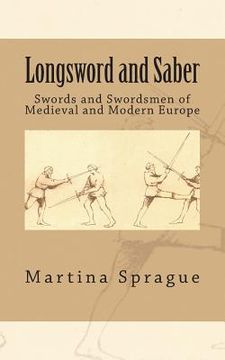Longsword and Saber: Swords and Swordsmen of Medieval and Modern Europe (en Inglés)
Reseña del libro "Longsword and Saber: Swords and Swordsmen of Medieval and Modern Europe (en Inglés)"
European swordsmanship has produced a large number of written treatises and has been studied widely by military historians and lay persons interested in the sword as a combat arm and instrument of social status. Swords had a dual purpose: They were of military necessity used by knights on the field of battle, and of social necessity carried by nobles to communicate rank and settle disputes of honor. The European longsword was primarily a cut and thrust weapon that found use in both cavalry and foot soldiering. A good sword could cut through armor, flesh, and bone, and would last for several subsequent battles without breaking.Due to its powerful image, the sword became a symbol of masculinity and strength. Noblemen started wearing swords also when in civilian dress. In Renaissance Europe, and through the industrial and technological revolution of the eighteenth and nineteenth centuries when gunpowder weapons became more reliable, the sword saw gradually less battlefield use and fencing for the purpose of dueling or sport gained in popularity.This book starts by discussing the role of the swordsmith and his understanding of sword dynamics for battlefield use. It analyzes the physical training of the swordsman and the techniques he committed himself to studying in order to defeat an enemy in battle, and the debate surrounding the "best" types of swords and training techniques. Next the book examines the use of the sword in mass armies, primarily the Crusades. It examines the saber and its use in nineteenth century infantry, cavalry, and naval warfare, followed by a discussion of the social mores of the times and the reasons why the sword evolved into a dueling and sport fencing weapon. The concluding remarks summarize the development of the sword from early medieval times to modern day.Knives, Swords, and Bayonets: A World History of Edged Weapon Warfare is a book series that examines the history of edged weapons in Europe, Asia, Africa, the Americas, and the Middle East and surrounding areas before gunpowder increased the distance between combatants. The book series takes a critical look at the relationship between the soldier, his weapon, and the social and political mores of the times. Each book examines the historical background and metallurgic science of the knife, sword, or bayonet respectively, and explores the handling characteristics and combat applications of each weapon. The individual books are excerpted from the previously published book, A History of Edged Weapon Warfare, also by Martina Sprague.The full series comprises the following books, which can be read in any order:1. Kukris and Gurkhas: Nepalese Kukri Combat Knives and the Men Who Wield Them2. Machete, Kris, and Throwing Iron: Edged Weapons of Latin America, Indonesia, and Africa3. Cold Steel: The Knife in Army, Navy, and Special Forces Operations4. Japanese Swords: The Katana and Gunto in Medieval and Modern Japanese Warfare5. Chinese Swords: The Evolution and Use of the Jian and Dao6. Yatagan, Khanda, and Jamdhar: Swords and Sabers of Persia and India7. Sickle Sword and Battle Axe: Edged Weapons of Ancient Egypt8. Gladius and Spatha: Swords and Warfare in the Classical World9. Longsword and Saber: Swords and Swordsmen of Medieval and Modern Europe10. Pike, Halberd, and Bayonet: Sharp Weapons in Near Modern and Modern WarfareNote that the books are written for those with an interest in exploring the historical beginnings of edged weaponry, how edged weapons have been used in war in different parts of the world, and the value the soldier attached to his weapon. Military, social, and political history is discussed. Arms collectors or others with detailed interest in the finer points of weaponsmithing may want to look for books that are more heavily illustrated.

